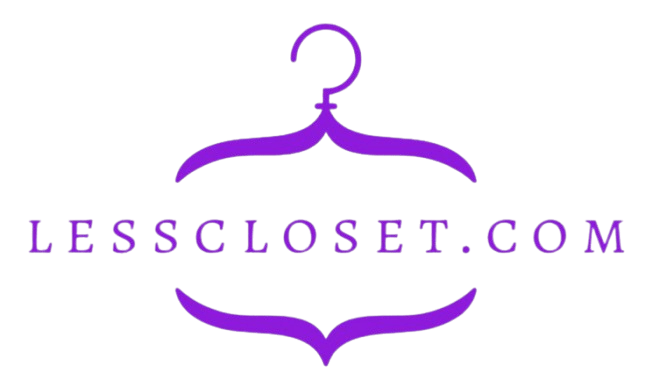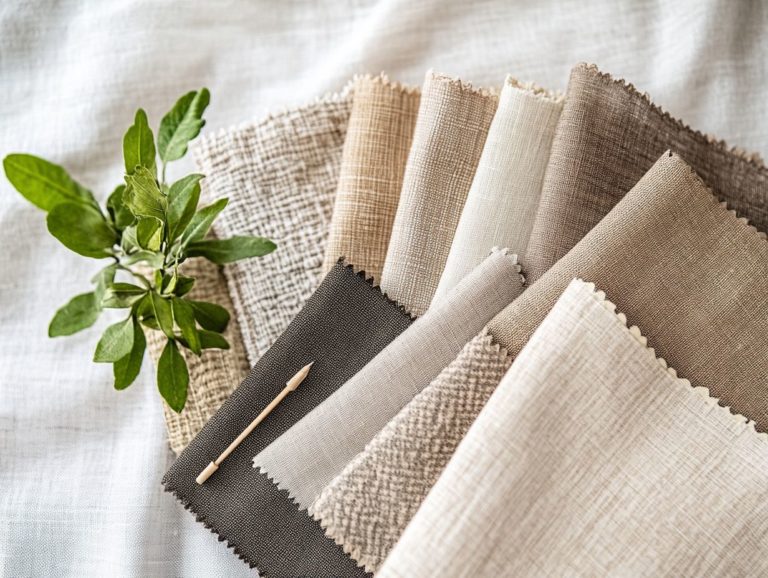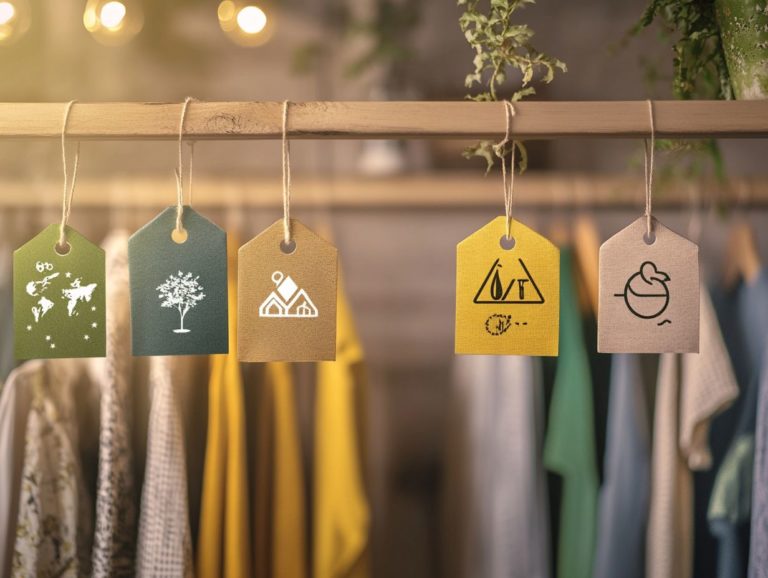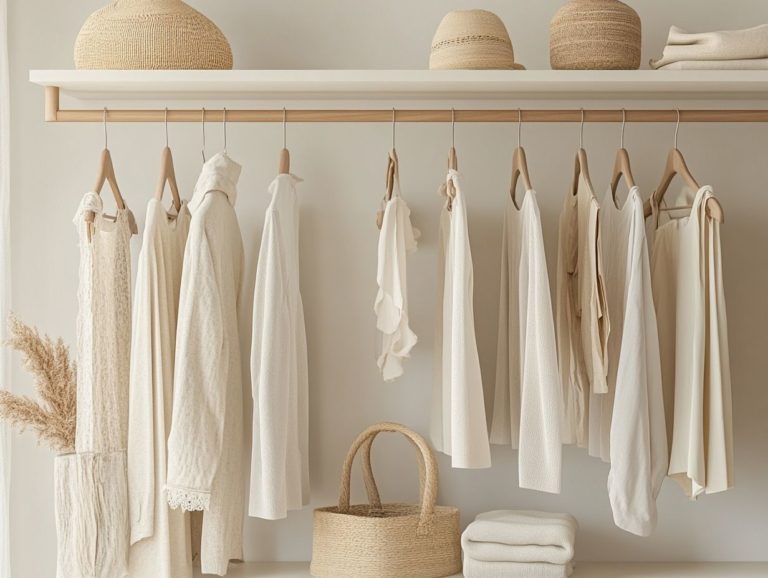Top 7 Sustainable Fashion Trends in 2024
As the fashion industry confronts its environmental impact, you ll find a new wave of sustainable practices taking center stage. In 2024, trends like circular fashion and slow fashion are redefining what style and consumption truly mean for you. This article delves into the top seven sustainable fashion trends, featuring exciting options like eco-friendly materials and the charm of secondhand shopping.
You ll also explore the significance of transparency and traceability in supply chains and the benefits of local production. Your choices can influence this evolving landscape. Discover how you can embrace a fashion ethos that is not only stylish but also sustainable.
Contents
- Key Takeaways:
- 1. Circular Fashion
- 2. Slow Fashion
- 3. Sustainable Materials
- 4. Transparency in Supply Chain
- 5. Secondhand and Thrift Shopping
- 6. Local and Ethical Production
- 7. Minimalism and Capsule Wardrobes
- What Is Sustainable Fashion and Why Is It Important?
- How Has the Fashion Industry Contributed to Environmental and Social Issues?
- What Are the Key Principles of Sustainable Fashion?
- How Can Consumers Support Sustainable Fashion?
- What Are the Challenges and Barriers to Sustainable Fashion?
- How Can the Fashion Industry Become More Sustainable?
- What Are the Predictions for Sustainable Fashion in the Future?
- Frequently Asked Questions
- What are the top 7 sustainable fashion trends in 2024?
- How can I incorporate these sustainable fashion trends into my wardrobe and make responsible fashion choices?
- Will following these sustainable fashion trends be more expensive?
- Why should I care about sustainable fashion trends?
- Are there any other sustainable fashion trends that will become popular in 2024?
- How can I stay updated on sustainable fashion trends for 2024?
Key Takeaways:

- Circular fashion will continue to gain popularity, with brands implementing circular designs and using recycled materials.
- Slow fashion will become a mainstream trend, encouraging consumers to invest in quality, long-lasting pieces rather than fast fashion.
- Transparency in supply chains and ethical manufacturing will become standard practices, allowing consumers to make more informed and ethical purchasing decisions.
1. Circular Fashion
Circular fashion embodies a transformative approach within the sustainable fashion movement. It invites you to embrace a closed-loop system that minimizes waste through resource reuse and promotes a circular economy.
This innovative model challenges the conventional linear fashion industry by highlighting the importance of recycling, upcycling the process of transforming waste materials into new, higher-quality products and utilizing biodegradable textiles. Ultimately, it aims to reduce the environmental impact tied to clothing production and consumption.
By prioritizing recycled fabrics, you not only conserve natural resources but also play a significant role in waste reduction. As discarded clothing is repurposed, the pressure on landfills eases, showcasing sustainable methods at the core of this model.
The use of biodegradable textiles and natural dyes ensures that when garments reach the end of their life cycle, they decompose naturally. This enriches soil health rather than contributing to pollution. Such eco-friendly materials are becoming essential in redefining how the fashion industry operates, cultivating an environment where sustainability seamlessly intertwines with style and function.
2. Slow Fashion
Slow fashion invites you to embrace a more thoughtful approach to clothing production and consumption. It prioritizes quality over quantity and emphasizes sustainable practices that minimize environmental impact.
This movement encourages you to make conscious fashion choices, supporting brands that engage in ethical manufacturing and promote minimalist aesthetics. By shifting your focus from fleeting trends to timeless pieces, this philosophy fosters a deeper appreciation for craftsmanship.
It cultivates a genuine connection with each garment. You are enabled to invest in clothing designed to last, standing in stark contrast to the fast fashion industry s relentless cycle of low-quality items that often find their way into landfills. Start making these choices today to be part of a fashion revolution!
By acknowledging the significant ecological footprint of mass-produced apparel, slow fashion presents a sustainable alternative. It advocates for eco-friendly materials and fair labor practices that benefit both artisans and the planet. This approach safeguards the environment and champions a more equitable fashion landscape for everyone.
3. Sustainable Materials
Your choice of sustainable materials is essential in crafting an eco-conscious fashion industry that emphasizes environmental responsibility. By opting for innovative options like organic cotton, recycled polyester, Tencel, and hemp, you re not just reducing the carbon footprint the total greenhouse gases emitted by a person or organization linked to textile production; you re also promoting responsible consumption and sustainable practices throughout the fashion supply chain.
Take organic cotton, for example. It s grown without harmful pesticides, resulting in healthier soils and ecosystems. Plus, it offers a luxuriously soft fabric for your enjoyment.
Then there s Tencel, derived from sustainably sourced wood pulp. It boasts excellent moisture-wicking properties and biodegradability, effectively minimizing waste.
Recycled polyester, made from post-consumer plastic, significantly curtails the need for virgin materials, contributing to a circular economy.
By embracing these sustainable choices, you re not only tackling urgent environmental challenges but also nurturing a culture of thoughtful consumption. You and others can make informed decisions that truly resonate with your values.
4. Transparency in Supply Chain
Transparency in the supply chain is becoming increasingly vital in the fashion industry, as consumers like you demand greater accountability regarding how your clothing is produced. This growing awareness has led to the emergence of various transparency initiatives.
As ethical practices take center stage in brand reputation, companies are compelled to adopt more responsible methodologies. By harnessing innovative technologies such as blockchain a secure digital record-keeping system they can effectively trace the journey of their products from raw materials to retail providing real-time information that enables you as a consumer.
Initiatives that reveal labor conditions, sourcing standards, and environmental impacts not only build trust but also encourage you to engage in responsible procurement behaviors. With greater access to this information, you’re enabled to make informed decisions that reflect your values. Ultimately, you hold brands accountable for their practices and promote a shift toward sustainability.
5. Secondhand and Thrift Shopping

Secondhand and thrift shopping has become your gateway to sustainable fashion, allowing you to embrace conscious consumption while making a meaningful impact on waste reduction in the textile industry. This trend not only makes fashion more affordable but also champions a circular economy by extending the lifespan of garments.
By opting for pre-loved items, you re not just uncovering unique treasures; you re actively participating in minimizing the environmental footprint of fast fashion. Platforms like Poshmark, Depop, and ThredUp have blossomed into vibrant communities that connect buyers and sellers, nurturing a culture of sustainability. Local thrift stores and charity shops often contribute a portion of their sales to social causes, amplifying the positive impact of every purchase you make.
Dive into the world of thrift shopping today and discover amazing finds! As you join others in this eco-friendly movement, you’re helping to redefine fashion norms and advocate for a more responsible approach to style, which includes practices like water reduction and energy-efficient practices.
6. Local and Ethical Production
Local and ethical production is crucial in the sustainable fashion movement, allowing you to embrace handmade skills while significantly reducing the carbon footprint linked to global supply chains. By choosing to support local communities and prioritizing ethical manufacturing practices, you can play a vital role in fostering social responsibility while minimizing the environmental impact of your fashion choices.
This approach strengthens community bonds; it also honors the rich heritage embedded in traditional crafts, which are often at risk of disappearing in a world dominated by mass production. When brands partner with local artisans, they help preserve unique skills, resulting in distinctive products that resonate with cultural stories.
Ethical manufacturing emphasizes fair wages and safe working conditions, tackling the systemic inequalities frequently found in the fashion industry. In this way, local production serves as a cornerstone for sustainable fashion, intertwining economic enablement with caring for the environment.
Your choices can truly make a difference!
7. Minimalism and Capsule Wardrobes
Embracing minimalism and creating capsule wardrobes a small collection of clothes that all work well together offers you a strategic pathway to sustainable fashion. This approach allows you to curate a versatile collection of clothing that promotes conscious consumption while reducing clutter.
It aligns beautifully with the slow fashion movement, a movement that focuses on making clothes more slowly and sustainably, emphasizing quality over quantity and encouraging thoughtful fashion choices. By focusing on fewer, high-quality pieces that can effortlessly mix and match, you re enabled to invest in styles that truly resonate with your personal aesthetic, rather than chasing after fleeting trends.
This curated method not only simplifies your daily dressing but also lessens the impact of fast fashion, which often prioritizes swift production over sustainable practices. Adopting these principles can deepen your appreciation for craftsmanship, urging you to support brands committed to ethical production methods and sustainable materials.
Ultimately, this helps build a healthier relationship with your clothing and the planet.
What Is Sustainable Fashion and Why Is It Important?
Sustainable fashion encompasses a wide array of practices designed to minimize the environmental footprint of the fashion industry while promoting social responsibility and ethical manufacturing. You play a crucial role in this movement, as consumer awareness is pivotal in steering towards a more sustainable future. More people like you are looking for better options every day!
By prioritizing eco-friendly materials, reducing waste, and advocating for fair labor practices, sustainable fashion represents a necessary shift in industry standards. Traditional fashion practices often contribute significantly to pollution and resource depletion, highlighting the critical need for immediate action.
As awareness continues to grow, you become a powerful catalyst for this transformation, demanding greater transparency and accountability from brands. Your choices not only foster innovation but also encourage a cultural shift that values quality over quantity, ensuring that the principles of sustainable fashion gain traction in a world eager for more responsible options.
How Has the Fashion Industry Contributed to Environmental and Social Issues?
The fashion industry has long been entwined with significant environmental and social challenges, from high carbon emissions to excessive waste and exploitative labor practices. This reality underscores the urgent need for sustainable development within the sector. As awareness of these issues amplifies, you and other consumers, along with brands, are increasingly driven to seek solutions that tackle these pressing concerns.
This shift in perspective is crucial. The industry contributes over 10% of global carbon emissions and generates staggering amounts of textile waste, much of which finds its way into landfills. In addition, labor practices in various garment-producing nations often infringe upon basic human rights, leaving workers in unsafe conditions and earning unlivable wages.
Tackling these intricate problems calls for a collective effort. It’s essential to advocate for a transformation that prioritizes eco-friendly materials, ethical labor practices, and responsible consumption habits. By doing so, you can help pave the way for a more sustainable future in fashion.
What Are the Key Principles of Sustainable Fashion?

The key principles of sustainable fashion center around ethical manufacturing, responsible consumption, and the promotion of a circular economy. These principles aim to cultivate a fashion landscape that values both people and the planet.
These principles provide a solid foundation for you as a consumer and for brands. They steer decisions that resonate with sustainability trends and contribute to a healthier environment.
In this framework, ethical manufacturing emphasizes fair labor practices, transparency throughout the supply chain, and minimizing environmental impact during production. When you choose to support brands that uphold these values, you re not just helping to reduce waste and pollution; you re also championing fair wages and safe working conditions for garment workers.
Responsible consumption encourages you to reflect on your purchasing habits critically. This often leads you to embrace second-hand shopping or invest in high-quality, timeless pieces instead of succumbing to the allure of fast fashion.
By nurturing these behaviors, you can play a significant role in the fashion industry’s contribution to a circular economy. This economy ensures materials are reused and recycled, utilizing resources efficiently and sustainably.
How Can Consumers Support Sustainable Fashion?
You play a crucial role in championing sustainable fashion by making informed choices that emphasize conscious consumption. This means opting for eco-friendly materials, supporting ethical supply chains, and embracing secondhand shopping.
Aligning your fashion choices with sustainability principles will drive demand for environmentally responsible practices within the industry. Thoughtfully selecting brands that demonstrate a commitment to reducing their environmental footprint and ensuring fair labor practices is essential.
Exploring local thrift shops or online resale platforms not only extends the lifecycle of clothing but also minimizes waste and curtails the need for new manufacturing.
Advocating for transparency in production processes allows you to hold brands accountable and encourages them to adopt more sustainable practices. Each deliberate purchase you make contributes to a larger movement aimed at revolutionizing how fashion is produced and consumed.
This paves the way for a more sustainable future for everyone. Join the movement for sustainable fashion!
What Are the Challenges and Barriers to Sustainable Fashion?
The challenges and barriers to sustainable fashion are complex. They span from limited consumer awareness to the absence of stringent green regulations in the industry, hampering progress toward a more sustainable future.
These obstacles call for a collaborative approach among brands, consumers, and policymakers to cultivate an environment where sustainable practices can thrive. It’s essential for you to understand the environmental impact of your purchasing choices.
Many remain blissfully unaware of the hidden costs tied to fast fashion. The lack of clear guidelines and incentives for brands often paves the way for greenwashing, which means companies mislead consumers about the sustainability of their products.
To tackle these issues, stakeholders be they activists, educators, or industry leaders can work together to enhance transparency and promote responsible consumption. Nurturing a culture of accountability and prioritizing ethical manufacturing processes is crucial.
The fashion sector can embark on a journey toward a more sustainable framework, ultimately creating lasting change.
How Can the Fashion Industry Become More Sustainable?
To enhance sustainability in the fashion industry, embrace innovative materials and sustainable practices that prioritize waste management and reduce your carbon footprint. Elevating overall environmental responsibility is key.
By adopting a mindset of continuous improvement, your brand can pave the way toward a greener future. This approach cultivates a culture of sustainability across all sectors.
Explore alternatives like fabrics made from natural materials, recycled textiles, and low-impact dyes. These not only reduce reliance on petroleum-based products but also minimize water usage throughout production.
Implementing circular economy principles can dramatically decrease waste. Design garments for longevity and recyclability. It’s crucial to prioritize partnerships with eco-conscious suppliers and invest in advanced technologies that streamline waste processing.
By taking these actionable steps, you can significantly lower carbon emissions and set a positive example for consumers. This enables them to make informed choices that support a sustainable lifestyle.
What Are the Predictions for Sustainable Fashion in the Future?
Predictions for sustainable fashion indicate greater integration of digital technology alongside a significant shift in consumer behavior toward eco-conscious choices. This shift is sparked by rising awareness of environmental impact.
As sustainability trends continue to evolve, the fashion industry is poised for transformation. This change will be shaped by innovative practices and a growing demand for transparency.
Advancements like blockchain technology help track the journey of clothing from production to sale, ensuring ethical practices. You may also see the emergence of artificial intelligence in design processes, leading to more efficient resource management.
As consumers, you re increasingly gravitating toward brands that align with your values. This compels companies to adopt sustainable practices.
The implications of these shifts for the fashion sector are significant. They have the potential to redefine standards for quality, production methods, and how brands communicate their sustainability efforts, fundamentally reshaping the marketplace.
Frequently Asked Questions

What are the top 7 sustainable fashion trends in 2024?
The top 7 sustainable fashion trends in 2024 are:
- 1. Circular Economy: This trend focuses on reducing waste and minimizing the environmental impact of fashion by promoting practices such as recycling, upcycling, and repurposing.
- 2. Slow Fashion: Slow fashion encourages consumers to invest in quality, timeless pieces made ethically and sustainably, rather than fast fashion items that contribute to overconsumption.
- 3. Vegan and Cruelty-Free Materials: With a growing awareness of animal welfare and environmental concerns, more fashion brands are using vegan and cruelty-free materials like organic cotton and recycled fabrics.
- 4. Transparency: Consumers are becoming more conscious of the impact their clothing has on people and the planet, demanding transparency in ethical supply chains and labor practices.
- 5. Digital Clothing: As technology advances, digital clothing is becoming a more sustainable option, utilizing virtual fitting and eliminating the need for physical production.
- 6. Rental and Second-Hand Fashion: Excitingly, rental and second-hand fashion platforms are making it easier than ever to join the circular economy!
- 7. Zero Waste Design: Designers are incorporating zero waste techniques into their designs, creating more sustainable and efficient production processes.
Join the sustainable fashion movement today and make a difference!
How can I incorporate these sustainable fashion trends into my wardrobe and make responsible fashion choices?
Start investing now in timeless pieces that elevate your style! Look for high-quality items made ethically and sustainably.
Support brands that prioritize transparency about their supply chains and environmental impacts. Renting or buying second-hand clothing can significantly reduce your fashion footprint.
Lastly, consider adding digital clothing for a more innovative and sustainable option. Explore eco-friendly fabrics too these are materials that are kind to our planet!
Will following these sustainable fashion trends be more expensive?
It depends on your approach. Investing in high-quality, timeless pieces may cost more upfront, but you’ll save money by not constantly buying new items.
Renting and buying second-hand can also be budget-friendly. While some sustainable materials might be pricier, remember that you’re investing in both fashion and the environment.
Why should I care about sustainable fashion trends?
Following sustainable fashion trends has a positive impact on the environment and supports social and economic goals.
It helps reduce your fashion footprint and promotes ethical practices, leading to a circular economy this means reusing and recycling items to minimize waste.
Sustainable fashion can also be innovative, providing unique and stylish pieces that may feature artisanal craftsmanship and cutting-edge materials.
Are there any other sustainable fashion trends that will become popular in 2024?
While we ve covered the top trends for 2024, many exciting developments are on the horizon!
Look out for biodegradable textiles, eco-friendly dyes, and practices like regenerative agriculture and carbon-neutral production.
The industry is evolving, bringing more attention to carbon emissions and consumer awareness.
How can I stay updated on sustainable fashion trends for 2024?
Don t miss out on the latest trends! Follow sustainable fashion influencers and bloggers, and read industry publications.
Engage with sustainable fashion brands on social media and keep an eye on organizations like the Global Fashion Agenda and Ellen MacArthur Foundation.
Attending sustainable fashion events and conferences is also a great way to learn about innovations in the industry!






